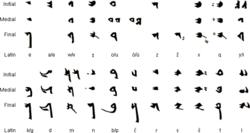Social:Old Uyghur alphabet
| Old Uyghur alphabet | |
|---|---|
| Type | Alphabet or abjad
|
| Languages | Old Uyghur, Western Yugur |
Time period | ca.700s–1800s |
Parent systems | |
Child systems | Traditional Mongolian alphabet |
| Direction | Mixed |
| ISO 15924 | Ougr, 143 |
| U+10F70–U+10FAF | |
The Old Uyghur alphabet was a Turkic script used for writing the Old Uyghur, a variety of Old Turkic spoken in Turpan and Gansu that is the ancestor of the modern Western Yugur language.[1] The term "Old Uyghur" used for this alphabet is misleading because Qocho, the Uyghur (Yugur) kingdom created in 843, originally used the Old Turkic alphabet. The Uyghur adopted this "Old Uyghur" script from local inhabitants when they migrated into Turfan after 840.[2] It was an adaptation of the Aramaic alphabet used for texts with Buddhist, Manichaean and Christian content for 700–800 years in Turpan. The last known manuscripts are dated to the 18th century. This was the prototype for the Mongolian and Manchu alphabets. The Old Uyghur alphabet was brought to Mongolia by Tata-tonga.
The Old Uyghur script was used between the 8th and 17th centuries primarily in the Tarim Basin of Central Asia, located in present-day Xinjiang Uygur Autonomous Region, China. The script flourished through the 15th century in Central Asia and parts of Iran, but it was eventually replaced by the Arabic script in the 16th century. Its usage was continued in Gansu through the 17th century.[3]
Characteristics
The Old Uyghur alphabet is a cursive-joining alphabet with features of an abjad. Letters join together at a baseline, and have both isolated and contextual forms, when they occur in initial, medial or final positions. The script is traditionally written vertically, from top to bottom and left to right. After the 14th century, some examples in a horizontal direction can be found. Words are separated by spaces.[3] Like the Sogdian alphabet (technically, an abjad), the Old Uyghur tended to use matres lectionis for the long vowels as well as for the short ones. The practice of leaving short vowels unrepresented was almost completely abandoned.[4] Thus, while ultimately deriving from a Semitic abjad, the Old Uyghur alphabet can be said to have been largely "alphabetized".[5]
Letters
Gallery
Jarlig of Temür Qutlugh
Unicode
The Old Uyghur alphabet was added to the Unicode Standard in September, 2021 with the release of version 14.0.
The Unicode block for Old Uyghur is U+10F70–U+10FAF:
See also
References
Citations
- ↑ Osman, Omarjan. (2013). L2/13-071 Proposal to Encode the Uyghur Script.
- ↑ Sinor, D. (1998), "Chapter 13 – Language situation and scripts", in Asimov, M.S.; Bosworth, C.E., History of Civilisations of Central Asia, 4 part II, UNESCO Publishing, pp. 333, ISBN 81-208-1596-3, https://unesdoc.unesco.org/ark:/48223/pf0000120455
- ↑ Jump up to: 3.0 3.1 Pandey, Anshuman (2020-12-18). "Final proposal to encode Old Uyghur in Unicode". https://www.unicode.org/L2/L2020/20191-old-uyghur.pdf.
- ↑ Clauson, Gerard. 2002. Studies in Turkic and Mongolic linguistics. P.110-111.
- ↑ Houston, Stephen D. 2004. The first writing: script invention as history and process (p.59).
Sources
- Gorelova, Liliya M. (2002). Manchu Grammar. Brill. ISBN 978-90-04-12307-6. https://books.google.com/books?id=KHwPAAAAYAAJ.
External links
- Latin to Old Uyghur transliteration
- Old Uyghur Alphabet on Omniglot
- Old Uyghur alphabet and Orkhon Turkic alphabet
 |





































































































